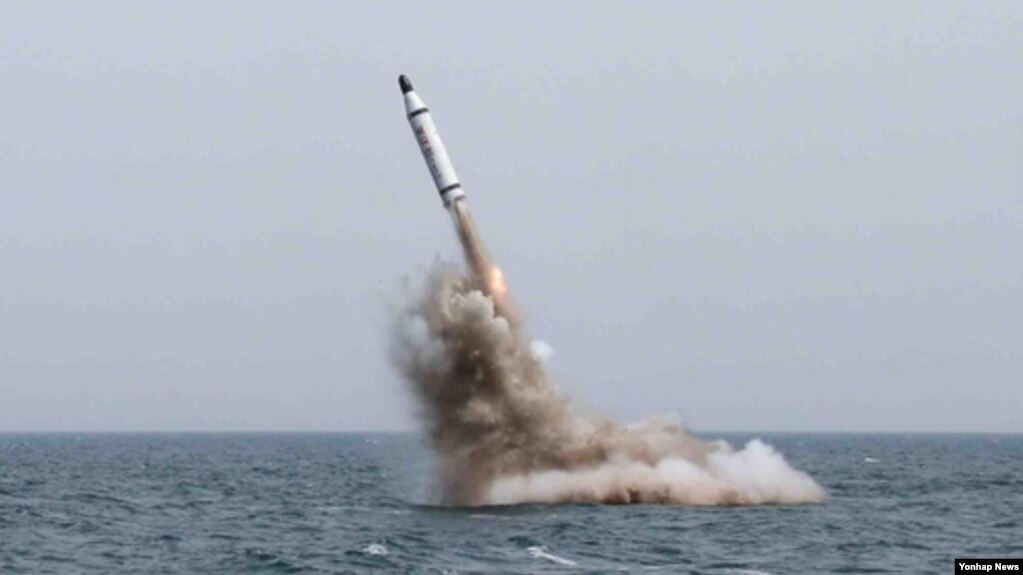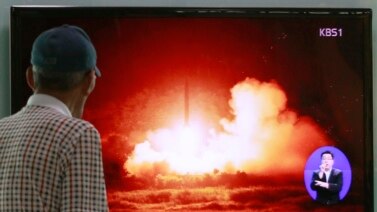
South Korean officials stated their concerns about North Korea’s first missile test launch from a submarine. The test does not immediately change the military situation on the Korean peninsula. However, it shows that North Korea is working on a missile system that is difficult to detect and could threaten countries around the world.
North Korea test-fires underwater missile
A spokesman for the South Korean Defense Ministry, Kim Min-seok, confirmed that North Korea did test-fire an underwater ballistic missile on May 8. He calls the test a serious concern. Mr. Kim also urged North Korea to stop developing the weapon immediately.
However, Mr. Kim also says the test shows North Korea is years away from deploying this new capability. He says the ministry believes North Korea’s test-fire shows the country is in the early stages of developing a submarine launched ballistic missile program. Mr. Kim says advanced countries take four to five years after an underwater test to complete the system.
What could North Korea’s new abilities mean?
However, the fact that North Korea is on a path to develop a submarine-based missile system means it could develop the ability to strike anywhere in the world. Targets could include the mainland of the United States.
The North’s new ability could also hurt the effectiveness of South Korea’s current Kill Chain missile system. This system is designed to target and destroy North Korean missile launch sites.
The increased North Korean threat could start a new arms race on the Korean peninsula. Some could also use the threat to justify deploying the United States anti-ballistic missile system called THAAD. South Korea has not wanted to accept the THAAD missile system because China opposes the move.
South Korea’s Defense Ministry spokesman says his country is sure it can, in his words, “strongly respond” to a missile attack from a North Korean submarine.
Some experts question the effectiveness of the launch
Bruce Bennett studies defense issues for the RAND Corporation, a research group. He said what North Korea got as a result of the test launch remains unclear.
“I haven’t seen any description of what exactly happened to the missile after it left the water,” Mr. Bennett said.
He also wondered if North Korea has a submarine equipped to fire a missile beyond the Korean peninsula.
But he noted that the launch represents a threat to South Korea and Japan.
“If you can fire two or three missiles at South Korea or Japan," he said, “that’s relatively a significant capability, and would require new efforts for defense against it.”
A nuclear weapon would raise the threat level
Defense expert Shin In-kyun is with the Korea Defense Network. He says South Korea needs to prevent missile attacks if the North moves to arm a ballistic missile with a nuclear weapon.
North Korea has not shown it can make a small nuclear warhead. However, U.S. military authorities recently said they believe North Korea has the ability to fit a nuclear weapon on a long distance missile.
Shin In-kyun says the U.S., South Korea and other allies need to develop the ability to contain this threat at its source.
He says the allies need to be able to launch a preemptive attack by deploying U.S. nuclear submarines. He says they could hide near North Korea’s submarine port on Mayong Island and strike the North’s submarine if there is an attack.
Political message
The submarine missile test took place days after U.S. and South Korean diplomats met to discuss the possibility of opening “exploratory talks” with the North. The two countries may be considering a compromise to meet North Korea’s demand for unconditional talks by using the work “exploratory” rather than “formal negotiations.” The compromise would temporarily suspend the U.S. demand that North Korea first take clear steps to halt its nuclear program.
Shin In-kyun says, by carrying out the missile test, North Korea is sending a message that it is not ready to offer any compromises on its own. North Korea wants the right to test-fire missiles in addition to restarting six-party talks without preconditions.
Leaders answer the test launch
The U.S. State Department has called on North Korea to avoid raising tensions in the area. It says launches using ballistic missile technology are a “clear violation” of U.N. Security Council resolutions. North Korea is under U.N. sanctions, which ban the country from developing or using ballistic missile technology.
North Korea’s official news agency, KCNA, reports that North Korean leader Kim Jong Un calls the launch “an eye-opening success.”
I'm Mario Ritter.
Brian Padden reported this story for VOA News from Seoul, South Korea. Mario Ritter adapted it for Leaning English. Kelly Jean Kelly was the editor.
Words in This Story
detect – v. to discover or notice the presence of something or someone; to find
ballistic missile – n. a weapon that is able to travel a long distance and then strike a target; a long-range missile
advanced – adj. beyond the basic level; far along in the course of progress
exploratory – adj. done or created to find something or to learn more about something
preconditions – n. something that must exist or happen before something else can exist or happen
